
Euphorbia is a very large and diverse genus of flowering plants, commonly called spurge, in the spurge family (Euphorbiaceae). "Euphorbia" is sometimes used in ordinary English to collectively refer to all members of Euphorbiaceae, not just to members of the genus. Some euphorbias are commercially widely available, such as poinsettias at Christmas. Some are commonly cultivated as ornamentals, or collected and highly valued for the aesthetic appearance of their unique floral structures, such as the crown of thorns plant. Euphorbias from the deserts of Southern Africa and Madagascar have evolved physical characteristics and forms similar to cacti of North and South America, so they are often incorrectly referred to as cacti. Some are used as ornamentals in landscaping, because of beautiful or striking overall forms, and drought and heat tolerance.

Euphorbia esula, commonly known as green spurge or leafy spurge, is a species of spurge native to central and southern Europe, and eastward through most of Asia north of the Himalaya to Korea and eastern Siberia.

Euphorbia amygdaloides, the wood spurge, is a species of flowering plant in the family Euphorbiaceae, native to woodland locations in Europe, Turkey and the Caucasus. It is a bushy evergreen perennial, growing to a height of 80 cm (31 in), with dark green slightly hairy leaves about 6 cm (2 in) long. The complex green-yellow inflorescence (cyathium), typical of Euphorbia, appears in late spring and early summer.

Euphorbia myrsinites, the myrtle spurge, blue spurge, or broad-leaved glaucous-spurge, is a succulent species in the spurge family Euphorbiaceae.
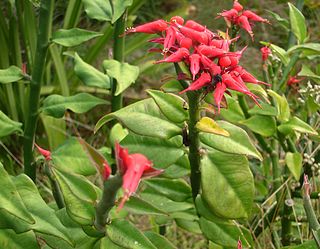
Euphorbia tithymaloides is a perennial succulent spurge. An erect shrub, the plant is also known by the scientific name Pedilanthus tithymaloides. However, the genus Pedilanthus has been submerged into the genus Euphorbia, and is more correctly known by its new name.
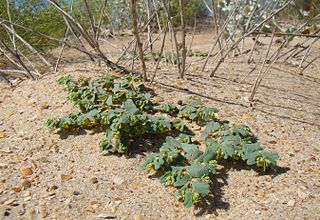
Euphorbia peplis, the purple spurge, is a species of Euphorbia, native to southern and western Europe, northern Africa, and southwestern Asia, where it typically grows on coastal sand and shingle.
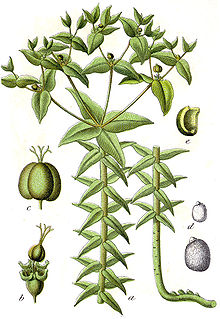
Euphorbia lathyris, the caper spurge or paper spurge, is a species of spurge native to southern Europe, northwest Africa, and eastward through southwest Asia to western China.
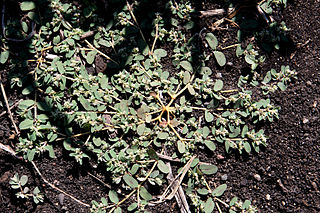
Euphorbia maculata, known as spotted spurge or prostrate spurge, the latter name not to be confused with Euphorbia prostrata, is a fast-growing annual plant in the family Euphorbiaceae, native to North America. It is a common garden and lawn weed in the United States.
Euphorbia eriantha is a species of spurge known by the common name beetle spurge. It is native to the deserts of northern Mexico and the southwestern United States from California to Texas. This is an annual herb reaching anywhere from 15 to 50 centimeters in height. The leaves are long, narrow, and pointed, sometimes with sparse hairs, and 2 to 7 centimeters long. The foliage may be dark in color, from greenish to purplish or reddish. The inflorescence appears at the tip of the branch and contains staminate or pistillate flowers which are just a few millimeters wide. The fruit is an oblong, hairy capsule half a centimeter long, with gray and black mottling. It contains bumpy white or gray seeds.
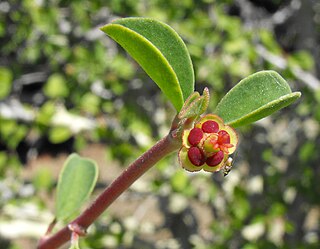
Euphorbia misera, known by the common name cliff spurge, is a species of spurge in western North America.
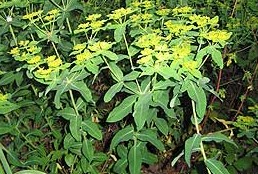
Euphorbia oblongata is a species of spurge known by the common names Balkan spurge, eggleaf spurge and oblong spurge. It is native to Eurasia but can be found elsewhere as a weedy introduced species. This is a hairy perennial herb growing to maximum heights of just over half a metre. It has oval-shaped or narrow leaves with finely toothed edges which are 4 to 6 centimetres long. The foliage is green to yellow-green. The inflorescences hold tiny glandular flowers. The fruit is a spherical capsule about half a centimetre long which contains smooth brown seeds.

The Euphorbiaceae, the spurge family, are a large family of flowering plants. In common English, they are sometimes called euphorbias, which is also the name of a genus in the family. Most spurges such as Euphorbia paralias are herbs, but some, especially in the tropics, are shrubs or trees, such as Hevea brasiliensis. Some, such as Euphorbia canariensis, are succulent and resemble cacti because of convergent evolution. This family occurs mainly in the tropics, with the majority of the species in the Indo-Malayan region and tropical America a strong second. A large variety occurs in tropical Africa, but they are not as abundant or varied as in the two other tropical regions. However, the Euphorbiaceae also have many species in nontropical areas such as the Mediterranean Basin, the Middle East, South Africa, and the Southern United States.

Euphorbia nutans is a species of Euphorbia known by the common names eyebane and nodding spurge. It is native to much of the United States, Eastern Canada, Mexico, Central America, the Caribbean, and Venezuela.

Euphorbia prostrata is a species of spurge known by the common name prostrate spurge or prostrate sandmat.
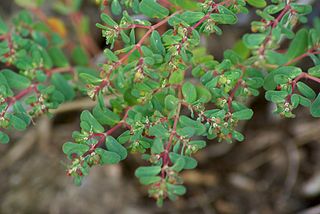
Euphorbia serpyllifolia is a species of euphorb known by the common names thymeleaf sandmat or thyme-leafed spurge. It is native to a large part of North America from Canada to Mexico, where it is a common member of the flora in many types of habitat. This is an annual herb growing as a prostrate mat or taking a somewhat erect form. The oblong leaves are up to about 1.5 centimeters long, sometimes hairy and finely toothed along the edges. The tiny inflorescence is a cyathium about a millimeter wide. It bears scalloped white petal-like appendages arranged around the actual flowers. At the center are several male flowers and one female flower, which develops into a lobed, oval fruit up to 2 millimeters wide. This plant had a number of traditional medicinal uses for many Native American groups.

Euphorbia balsamifera is a flowering plant in the spurge family Euphorbiaceae. It is distributed from Arabian Peninsula to Sahara and Canary Islands. It is the vegetable symbol of the island of Lanzarote.

Euphorbia hirta is a pantropical weed, originating from the tropical regions of the Americas. It is a hairy herb that grows in open grasslands, roadsides and pathways in the warmer regions of India and Australia as an introduced species. It is used in traditional herbal medicine.
Euphorbia purpurea is a species of Euphorbia known by the common names Darlington's glade spurge, glade spurge, and purple spurge. It is native to the eastern United States, where it occurs from Ohio and Pennsylvania south to North Carolina. It has been extirpated from Alabama; it was believed lost from Delaware until a population was rediscovered in 1997.
Euphorbia gregersenii, or Gregersen's spurge, is a plant in the family Euphorbiaceae: spurges.
















